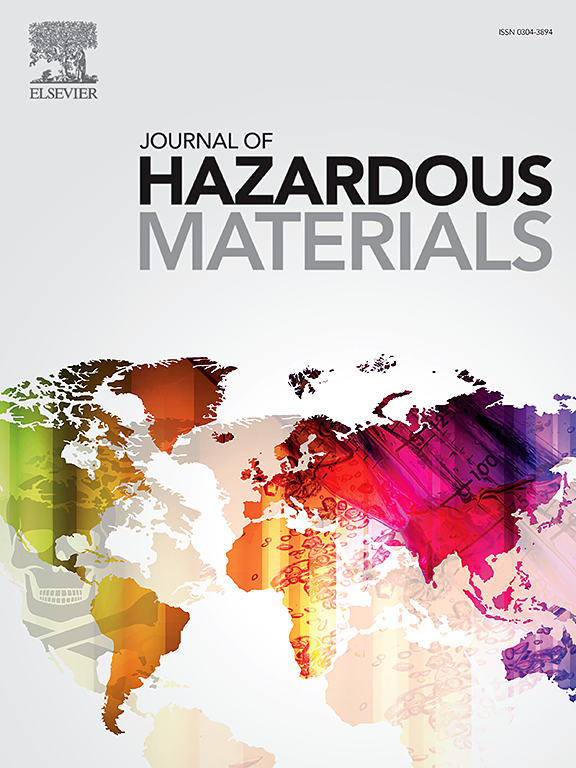吡唑菌酯通过群体感应诱导大肠杆菌耐多药:一个新的视角
IF 12.2
1区 环境科学与生态学
Q1 ENGINEERING, ENVIRONMENTAL
引用次数: 0
摘要
抗生素耐药性严重威胁着全球公共卫生,而农药等非抗生素化学品可能助长抗生素耐药性的发展。群体感应(Quorum sensing, QS)是一种调节群体行为的细胞间通讯系统,可能成为抗生素耐药性发展的一个途径。本研究首次发现,暴露于0.5 mg/L的吡氯菌酯可激活QS,导致大肠杆菌对抗生素产生耐药性,对所测抗生素的最低抑制浓度(mic)增加高达128倍。机制上,pyraclostrobin应激诱导luxS基因高表达,使QS信号分子(AI-2)水平升高,导致耐药菌(ARB) QS增强,从而上调多药外排泵基因(acrB和marA)表达,下调外膜孔蛋白基因(ompC和ompF)表达。同时,使用QS抑制剂也提高了菌株的抗生素敏感性。此外,pyraclostrobin暴露损伤细胞膜,诱导氧化应激,引起基因突变,进一步促进多药耐药。综上所述,pyraclostrobin暴露可通过激活QS和诱导基因突变刺激大肠杆菌耐药。因此,严格使用杀菌剂对抑制抗生素耐药性的发展至关重要。本文章由计算机程序翻译,如有差异,请以英文原文为准。

Pyraclostrobin induces multi-antibiotic resistance in Escherichia coli via quorum sensing: A new perspective
Antibiotic resistance seriously threatens to global public health, and non-antibiotic chemicals like pesticides can contribute to its development. Quorum sensing (QS) is an intercellular communication system that regulates group behavior and can potentially become a pathway for the development of antibiotic resistance. This study firstly discovered that exposure to pyraclostrobin at 0.5 mg/L activated QS, resulting in antibiotic resistance in Escherichia coli, with minimum inhibitory concentrations (MICs) increasing by up to 128-fold against tested antibiotics. Mechanistically, the high expression of the luxS gene induced by pyraclostrobin stress increased the level of the QS signal molecule (AI-2), leading to enhanced QS in antibiotic-resistant bacteria (ARB), thereby upregulating the expression of multidrug efflux pump genes (acrB and marA) and downregulating the expression of outer membrane porin genes (ompC and ompF). Meanwhile, using a QS inhibitor also increased the strains’ antibiotic sensitivity. Additionally, pyraclostrobin exposure damaged cell membranes, induced oxidative stress, and caused gene mutations, further promoting multidrug resistance. Overall, the findings demonstrate that pyraclostrobin exposure can stimulate antibiotic resistance in Escherichia coli by activating QS and inducing gene mutations. Therefore, the rigorous application of fungicides is essential to retard the development of antibiotic resistance.
求助全文
通过发布文献求助,成功后即可免费获取论文全文。
去求助
来源期刊

Journal of Hazardous Materials
工程技术-工程:环境
CiteScore
25.40
自引率
5.90%
发文量
3059
审稿时长
58 days
期刊介绍:
The Journal of Hazardous Materials serves as a global platform for promoting cutting-edge research in the field of Environmental Science and Engineering. Our publication features a wide range of articles, including full-length research papers, review articles, and perspectives, with the aim of enhancing our understanding of the dangers and risks associated with various materials concerning public health and the environment. It is important to note that the term "environmental contaminants" refers specifically to substances that pose hazardous effects through contamination, while excluding those that do not have such impacts on the environment or human health. Moreover, we emphasize the distinction between wastes and hazardous materials in order to provide further clarity on the scope of the journal. We have a keen interest in exploring specific compounds and microbial agents that have adverse effects on the environment.
 求助内容:
求助内容: 应助结果提醒方式:
应助结果提醒方式:


